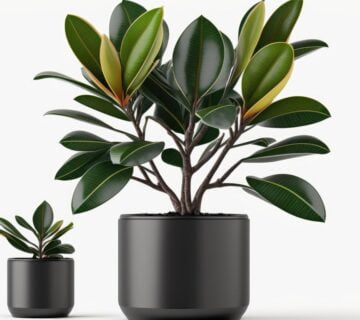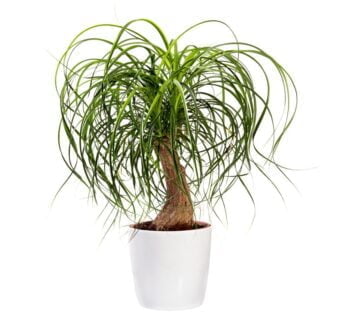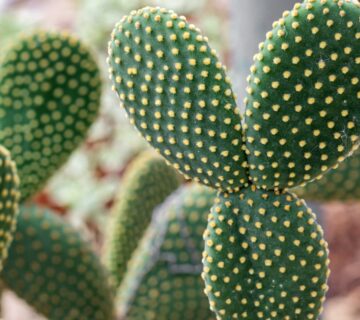String of Pearls
String of Pearls (Curio rowleyanus) is a fascinating succulent known for its distinct bead-like leaves that resemble a string of pearls. Native to South Africa, this unique plant has gained popularity among plant enthusiasts and succulent lovers for its striking appearance and easy care requirements.
Origin and Taxonomy:
String of Pearls, scientifically known as Curio rowleyanus, belongs to the Asteraceae family. It is native to the arid regions of Southwest Africa, particularly Namibia.
Growth Habit:
Curio rowleyanus exhibits a trailing growth habit, with its long, slender stems cascading down and resembling a string of beads. This growth pattern makes it an ideal choice for hanging baskets, elevated planters, or as a unique addition to succulent arrangements.
Leaf Characteristics:
The leaves of String of Pearls are spherical, pea-like, and smooth, resembling tiny pearls. These specialized leaves store water, allowing the plant to survive in arid conditions. The leaves are green but may also have a slightly bluish hue under certain light conditions.
Light Requirements:
String of Pearls thrives in bright, indirect light. It can tolerate some direct sunlight, especially during the morning or evening, but intense, prolonged sunlight may cause leaf burn. Placing the plant near a sunny window or providing filtered light outdoors is ideal.
Watering Needs:
Curio rowleyanus is a drought-tolerant succulent and should be watered sparingly. It is essential to allow the soil to dry out completely between waterings. Overwatering can lead to root rot, so ensuring the soil has proper drainage and avoiding waterlogged conditions is crucial.
Soil Requirements:
String of Pearls prefers well-draining soil to prevent moisture retention around its roots. A commercial succulent or cactus potting mix works well for this plant. Adding perlite or coarse sand to the soil mix can enhance drainage and aeration.
Temperature and Humidity:
Curio rowleyanus thrives in moderate temperatures ranging from 65°F to 75°F (18°C to 24°C). It can tolerate slightly higher or lower temperatures, but extreme heat or frost should be avoided. This succulent is adaptable to average indoor humidity levels and does not require high humidity.
Propagation:
Propagating String of Pearls can be done through stem cuttings. Healthy stems can be cut and left to callus before planting in well-draining soil. Roots will develop from the nodes, and new growth will emerge from the cuttings. This plant can also propagate from leaf cuttings, although it may be more challenging.
Common Pests and Diseases:
String of Pearls is generally resistant to pests and diseases. However, overwatering or prolonged exposure to high humidity can make it susceptible to fungal diseases and rot. Proper watering practices, good air circulation, and avoiding overcrowding of plants can help prevent these issues.
Decorative Appeal and Uses:
String of Pearls adds a unique and captivating touch to any indoor or outdoor space. Its cascading stems with pearl-like leaves create a visually striking display. It is often used in hanging baskets, trailing over shelves, or as a focal point in succulent arrangements. Its low maintenance requirements
Things to know about STRING OF PEARLS
Common (vernacular) Name
स्ट्रिंग ऑफ़ पर्ल्स (Hindi), String of Pearls, String of Beads, String of Marbles, Boesmankrale (Afr.) and many more.
Botanical Name
Curio rowleyanus, formerly known as Senecio rowleyanus
Origin
Southwestern Africa
Family
Asteraceae
Plant Type
Tropical plant
Plant Features
Ornamental / Evergreen / Exotic
Life Cycle
Perennial
Landscape Uses
Hanging Basket, Container Planting and Houseplants.
USDA Hardiness Zones
9 to 12
Species
Senecio rowleyanus, Senecio citriformis, Senecio herreianus, Senecio rowleyanus ‘Variegata’, Senecio herreianus ‘Purple Flush’, Senecio herreanus ‘Variegata’.
Varieties
It comes with six different varieties in a diversity of leaf and colorations.
Size
Height : 2 to 3 feet tall and Width : 1 to 2 feet wide when mature.
Indoors or Outdoors
Outdoors : String of Pearls can be used outdoors in shady plantings, avoid direct sun light.
Indoors : Excellent plant grow in sunny window bright light.
Blooming / Flowering
Blooming period is summer and winter season.
Flower Colour
It’s come with white discoid flowers with long red stamens and bright yellow anthers on 1½ inch long peduncles.
Lucky Plant
According to Feng Shui or Vastu Shastra, String of pearls does not have commonly known cultural, religious, or spiritual significance.
Lighting / Sun Exposure
Expose it to 3-4 hours of bright direct sunlight or partial shade.
Temperature
Grow best preferably warm temperature above 21°C and can be tolerate max temp. as high as 26.6°C.
Growth Rate
String of pearls is a fast-growing succulent plant and it can grow up to 5 - 15 inches per year.
Watering
Moderate watering. It is a drought tolerant string succulent. Not tolerate overwatering it may cause root rot.
Fertilizer
Slow-release fertilizer, or a water-soluble liquid fertilizer once or twice in the growing season (Spring through Summer).
i.e. - Compost, NPK 10-10-10 fertilizer, liquid organic fertilizer etc.
Pruning
Pruning of String of pearls not much is needed. However, trimming away only maintain its size or appearance.
Propagation
Seeds : This plant can also be grown from seed but it is not commonly available. It is very difficult and not recommended.
Stem Cuttings : The easier methods of propagation of String Of Pearls in moist potting mix soil via stem cuttings, and can be done during the spring and summer season.
Division : Division of String of pearls can be done in Rainy season, or better in spring growing season February to March.
Dormancy Period
Month : November to February (winter season)
Shed their leaves and show poor growth, Watering minimally.
Avoid : Propagate, Fertilize and Repotting.
Container
Ceramic Pot, Plastic Pot, Terracotta or Clay Pot is preferred, which ensures good drainage as well as water holding capacity.
Soil Type
A well-drained Loam / Coarse potting soil is recommended as well as water holding capacity. Prevent soggy potting medium.
Our recommendation for potting mix : Garden Soil (15%) + Compost (15%) + Perlite (25%) + Sharp Sand (30%) + Cocopeat soaked in water (15%) + Fungicide (1-2 tsp). You can substitute Grit, Pumice etc.
Soil pH
Neutral to Acidic - Ideally 6.6 to 7.5 pH (potential of hydrogen) is recommended for String of Pearls.
Repotting
The string of pearls doesn’t need repotting often because of plants have a smaller root system. These plants can go without repotting for a long time. If required then it should ideally once every 5 years at the beginning of spring.
Maintenance
Low maintenance and very easy to care.
Properties
Toxic to both humans and pets upon ingestion.
Benefits
String of Pearls flower helps to keep calm and improve mood. It contains Antimicrobial and Anticancer properties.
Special Features
Doesn't attract hummingbirds and pollinators like butterflies and bees or wasps.
Infestation / Pests
Aphids, mites, whiteflies, gnats, mealybugs, and ants etc.
Diseases / Problem
Physiological Problem : Anthracnose, Leaf Spot and Powdery Mildew.
Bacterial Problem : Bacterial Blight, Bacterial Wilt and Black Nose Disease.
Fungal Problems : Root Rot and Water Mold.
Some Glimpse of String Of Pearls











No comment